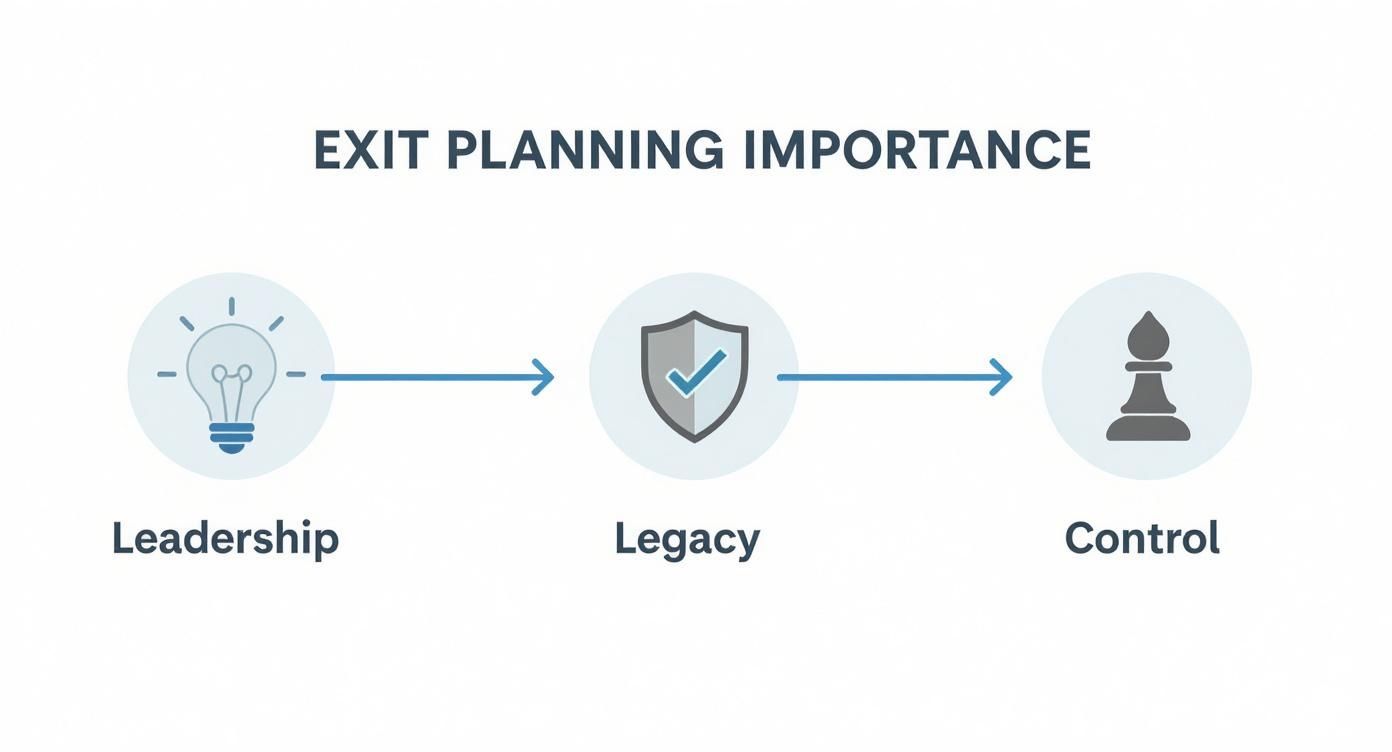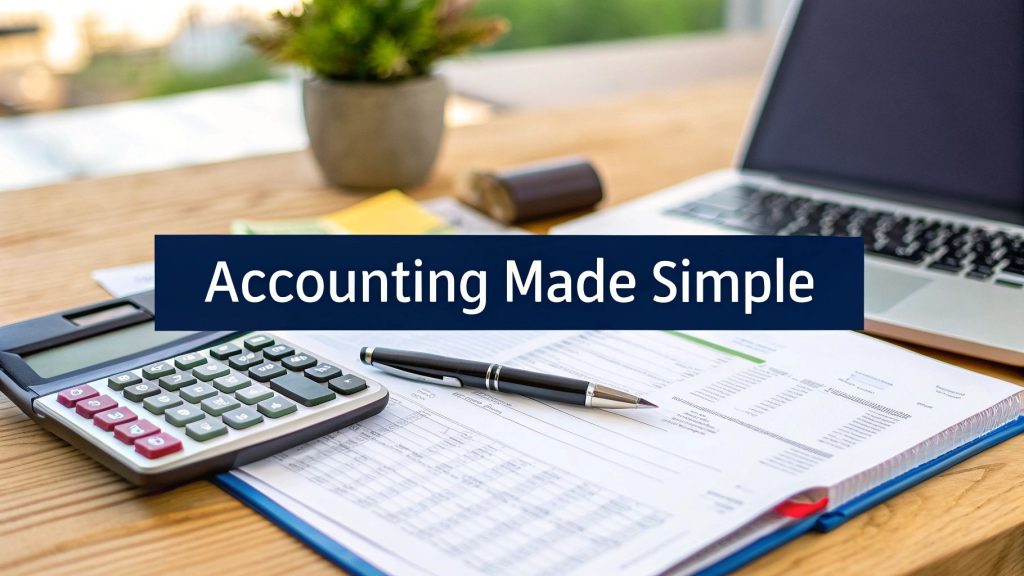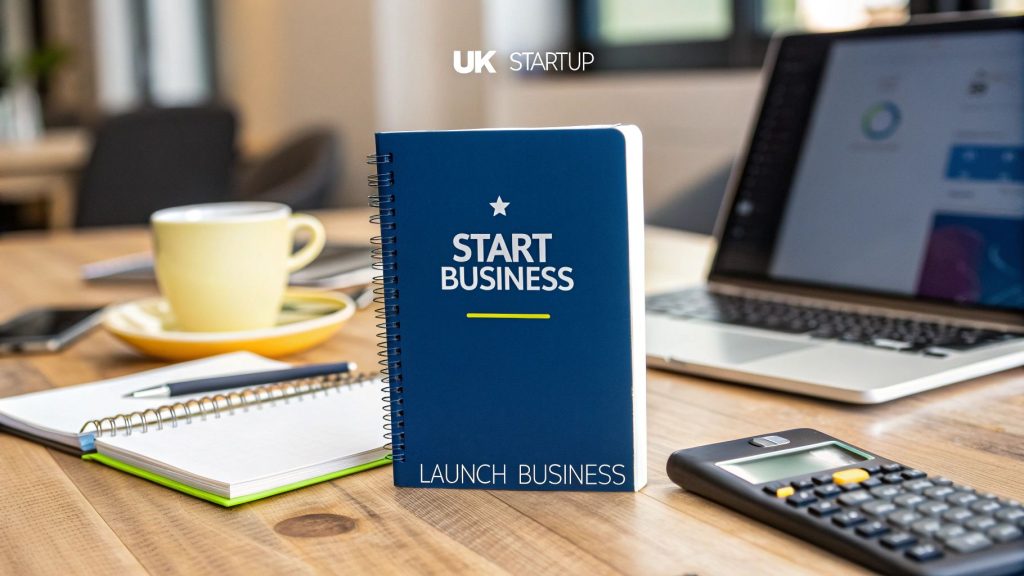Business Exit Strategy Planning Done Right
Business Exit Strategy Planning Done Right – Planning your business exit strategy isn’t about giving up; it’s about making sure you leave your company on your terms, with as few surprises as possible. A solid plan secures your team’s future and gives you crucial financial peace of mind.
Why You Need to Plan Your Exit Sooner Than You Think
Nobody loves thinking about the day they’ll hand over the keys to the business they built. But trust me, preparing your exit well before you intend to leave can be the difference between a rewarding sale and a fire sale you’re forced into.
- You’ll have far more negotiation power when you know exactly what your business is worth.
- A clear succession path keeps your team motivated and the business stable.
- It leads to much better tax and financial outcomes, protecting your personal wealth.
Thinking about your exit from day one forces you to align your personal goals with your business objectives. It’s a proactive approach that massively reduces stress and lets you pivot if life throws you a curveball.
Early planning is also fantastic for spotting hidden weaknesses. It shines a light on roles the business can’t function without, fragile revenue streams, and other risks that need your attention now, not when a buyer finds them during due diligence.
“An exit plan doesn’t signal defeat; it doubles as proof of strategic foresight and leadership.” — Anonymous CEO
Spotting Your Operational Blind Spots
Simple audits can be incredibly revealing. A manufacturing owner I spoke to discovered his finance manager was the only person in the entire company who knew how their pricing worked. If she’d left unexpectedly, it would have been chaos.
Getting into the habit of regular health checks on your financial statements keeps them clean and ready for a buyer’s scrutiny. Bringing in an adviser adds a vital objective perspective and helps you set projections that are ambitious but believable.
- Schedule quarterly reviews of your accounts. Don’t let things slide.
- Document any off-balance-sheet items or contingent liabilities. Transparency is key.
- Use cloud-based accounting tools to keep everything organised and transparent.
It’s shocking, but nearly half (48%) of UK business owners have no exit strategy at all. This leaves them wide open to rushed decisions and taking a serious hit on their valuation. You can read the full research about exit planning strategies to see just how common this is.
Building Your Confidence for Negotiations
When you can walk into a negotiation with realistic timelines and clear performance milestones, your credibility soars. Buyers have a lot more respect for sellers who can point to a track record of hitting growth targets.
Practical Example: A boutique retailer in Brighton prepared a slide deck showing month-on-month profit improvements and customer acquisition cost reductions. During negotiations, this data convinced the buyer to increase their offer by 15%.
Making Your Legacy Part of the Plan
Don’t frame your exit as an ending. Position it as the next logical step in the company’s leadership journey. When you do that, everyone is more likely to get on board.
Be open about your vision for the company’s future ownership and, where appropriate, involve your key managers in the planning.
One tech founder I know invited three of his senior developers to help draft a long-term maintenance roadmap. That document didn’t just help with the transition; it now forms the backbone of the sale agreement.
For ideas on how to frame your business’s story concisely, our guide on business plan executive summary examples has some great pointers for grabbing a buyer’s attention.
- Track progress on your exit goals with clear, achievable milestones.
By weaving exit planning into the normal rhythm of your business, you turn what feels like a daunting task into a powerful strategic advantage. When the time finally comes to step away, you’ll do so with full confidence in the value you’ve created and the legacy you’re leaving behind.
Setting the Stage for a Successful Exit
Before you even think about putting a ‘For Sale’ sign on your business, you need to get brutally honest about where you stand right now. The first step is figuring out your personal financial finish line—what’s the magic number you need to walk away with to live the life you want?
It’s easy to pluck a figure out of thin air, but you need to be realistic. For example, you might decide you need £1 million in your pocket after the sale. That means accounting for taxes, professional fees, and having enough left to invest for a comfortable future. Getting this number wrong is a classic mistake that can leave you short-changed.
Once you have your number, the focus shifts to the health of your business. The big question is: can it survive without you? I’ve seen too many fantastic businesses grind to a halt the moment the founder takes a step back. This often reveals hidden dependencies that were never addressed. A key person audit is the best way to uncover these fragile links before they become a deal-breaker for a potential buyer.
Identifying Critical Dependencies
An audit is all about spotting the people whose absence would derail the entire operation. You need to look for:
- Single points of failure, where only one person knows how to handle a vital process.
- Missing documentation, trapping crucial expertise inside team members’ heads instead of in a company manual.
- A lack of cross-training, creating bottlenecks where simple tasks can’t be completed if someone is off sick.
A simple skills matrix can work wonders here. It helps you see who knows what, assign backups, and start spreading that essential knowledge across the team.
The infographic below gives a great visual overview of the three core pillars of exit planning.

As the chart shows, Leadership, Legacy, and Control are the absolute cornerstones of a well-thought-out exit strategy.
Testing Your Financial Finish Line
Calculating your magic number is more than just a back-of-the-envelope sum. You have to factor in everything: future healthcare costs, holidays, hobbies, and a buffer for emergencies. A detailed cashflow forecast showing your expected monthly outgoings is the only way to confirm if your nest egg will actually last.
Ask yourself these questions:
- What annual withdrawal rate can my savings sustain without running out?
- Have I stress-tested my plan against a potential recession or market crash?
- Are my investments properly diversified to manage risk?
Practical Example: A consulting firm’s founder modelled ‘what if’ scenarios using the cashflow forecast and realised his target of £800k would require a 15% reduction in living expenses. He then adjusted his lifestyle projections to maintain a comfortable buffer.
Working with Advisors on Your Timeline
A realistic timeline is what turns a vague goal into a series of achievable milestones. This is where bringing in a professional advisor can provide some much-needed clarity on market timing and how fast you really need to grow.
I remember a UK manufacturing firm owner who thought he was a year away from selling. After an advisor reviewed his operations, he realised he needed three more years—not just to hit his revenue targets, but to make the business completely self-reliant and attractive to buyers.
Good planning starts with understanding your end goals and working backwards.
To build a solid timeline, you should:
- Analyse your current performance metrics to establish a reliable baseline.
- Compare your growth rates with industry benchmarks to see if your plan is realistic.
- Document and streamline all your key processes so the business can run smoothly without you.
This kind of disciplined planning puts you in a much stronger position when it’s time to negotiate. For more on preparing for the unexpected, our guide on a business risk management framework is a great resource for shoring up potential threats.
Balancing Personal and Business Goals
Let’s be honest, preparing for an exit isn’t just about spreadsheets and processes. It’s also deeply personal. You need to align your own aspirations with the company’s future. Maybe you’re dreaming of travelling the world, spending more time with the grandkids, or even starting a completely new venture.
Here are a few practical tips to help you keep that balance:
- Schedule regular check-ins with your family or a mentor to talk through how you’re feeling.
- Carve out a bit of time each month for a personal project that has nothing to do with the business.
- Use reflection exercises like journaling to keep track of your progress and your own wellbeing.
Remember, an exit driven by burnout is almost always a rushed one, and that can seriously undercut your business’s value. When your personal goals are aligned with your operational plans, you reduce stress and stay motivated right through to the finish line.
It also pays to create a few contingency plans. Think about what would trigger an earlier or different kind of exit—a sudden market downturn, a health issue, or an unexpected buyout offer. For each scenario, draft some clear actions and assign responsibilities so you can respond quickly and effectively.
Up next, we’ll dive into how to value your business accurately to make it as appealing as possible to potential buyers.
How to Accurately Value Your Business

Figuring out what your business is really worth is easily the most emotional and misunderstood part of any exit. It’s a blend of cold, hard numbers and warm, fuzzy market perception—more art than science. Too many owners get it wrong, either letting sentiment inflate their expectations or overlooking hidden gems that could add serious value.
A proper valuation isn’t just a reflection of your last P&L statement. It’s about seeing your company through a buyer’s eyes. They aren’t just buying your history; they’re buying its future potential and, crucially, inheriting its risks.
I once saw a digital marketing agency owner in Manchester who was convinced their high annual turnover guaranteed a massive payday. A professional valuation told a very different story. It turned out that 70% of their revenue came from a single client—a huge red flag for any buyer. That one fact dramatically adjusted the final price tag, a classic pitfall that a thorough valuation brings to light.
Understanding Common Valuation Methods
Before you dive into your business exit strategy planning, you need to get your head around the basic ways a business is valued. You don’t need to be an accountant, but understanding the language will help you have a much more productive conversation with advisors and potential buyers.
There are a few core methods that most valuers use, each telling a slightly different part of your company’s story.
Here’s a quick comparison of the most common valuation methods you’ll come across in the UK.
Common Business Valuation Methods Compared
| Valuation Method | How It Works | Best For |
|---|---|---|
| EBITDA Multiples | Takes your Earnings Before Interest, Taxes, Depreciation, and Amortisation (EBITDA) and multiplies it by an industry-specific number. A stable software firm might get an 8x multiple, while a local café might only get 3x. | Businesses with consistent, positive earnings. It’s a quick and widely understood benchmark for profitability. |
| Discounted Cash Flow (DCF) | Projects your business’s future cash flows for several years and then “discounts” them back to what they’re worth today. It’s complex but forward-looking. | Companies with strong, predictable growth potential. Sophisticated buyers love this as it focuses on future returns, not just past performance. |
| Asset-Based Valuation | A straightforward calculation of the total value of your company’s assets (property, equipment, stock) minus all its liabilities. | Businesses that are asset-heavy, not currently profitable, or facing liquidation. It effectively sets a baseline “floor” value for the business. |
A smart buyer won’t just pick one. They’ll likely use a combination of these to build a complete picture and arrive at what they believe is a fair offer.
A business valuation isn’t a fixed number carved in stone. It’s a range, influenced by market timing, buyer motivation, and the quality of your financial records.
Looking Beyond the Balance Sheet
The biggest mistake you can make is thinking valuation is purely a numbers game. Some of your most valuable assets won’t appear on any balance sheet. These are the intangible elements that create a competitive “moat” around your business, making it tough for others to copy what you do.
So, what really moves the needle for a buyer?
- Brand Reputation: Is your name trusted in the market? A strong brand is incredibly valuable and takes years to build, making it a massive asset.
- Customer Loyalty: A business with a high rate of repeat custom or sticky, subscription-based revenue is far less risky than one constantly chasing new leads.
- Intellectual Property (IP): This could be patents, trademarks, proprietary software, or even a unique, documented process that gives you a clear edge.
- A Strong Management Team: This is a big one. If the business can thrive without you, its value skyrockets. It proves the company is a sustainable operation, not just a one-person show.
Example: A local law firm highlighted its five-year client retention rate of 92% in the pitch book, boosting buyer confidence beyond the numbers.
Practical Steps to Maximise Your Valuation
The great news is that your valuation isn’t set in stone. You can actively work to increase it in the years leading up to your exit. It all comes down to de-risking the business and strengthening its foundations.
First, get your financial house in pristine order. This means having at least three years of clean, professionally prepared or audited financial statements ready to go. Any inconsistencies or messy bookkeeping will create doubt and drive down the price.
Next, attack any concentration risk. Just like the agency owner, being over-reliant on a few clients is a huge red flag. Work on diversifying your customer base so that no single client accounts for more than 10-15% of your total revenue.
Finally, document everything. Create Standard Operating Procedures (SOPs) for every key function in the business. This documentation is proof that the “secret sauce” is part of the company’s systems and won’t walk out the door when you do.
Finding the Right Exit Path For You
Every founder’s dream takes its own shape. Some crave a swift payout; others want their legacy to live on. Pinpointing what matters most to you kick-starts truly effective business exit strategy planning.
Recent data from a survey of 250 UK small business owners shows 79% have no formal exit plan. Of those considering options, 47% lean towards selling to an unrelated third party, 46% favour family succession, 41% are open to selling to a partner, and 38% each would either wind down or seek acquisition by a larger company. You can explore these figures further in the UK business exit strategy findings.
Comparing Exit Options
Every route brings its own mix of gains and trade-offs. Selling to an external buyer can deliver maximum cash—but at the potential cost of your company’s culture. Passing the baton to family preserves your name, yet demands time and training.
| Exit Path | Pros | Cons |
|---|---|---|
| Selling to Third Party | High cash payout; clear market valuation | Culture shift; potential staff upheaval |
| Family Succession | Legacy preserved; smooth leadership transfer | Family conflict; uneven management skills |
| Management Buy-Out (MBO) | Motivated internal team; continuity | Complex financing; negotiation delays |
| Employee Ownership Trust | Tax advantages; independent structure | Setup complexity; trustee governance |
- If you need an immediate cash injection and can step away, selling externally often feels right.
- When relatives share your vision and you want a seamless handover, family succession shines.
- An MBO rewards loyal managers and keeps the business rolling.
- EOTs suit founders keen on employee-driven stewardship and long-term autonomy.
Practical Family Succession Scenario
In a Yorkshire bakery, Mrs Patel spent two years mentoring her daughter on recipes and supplier talks. They captured every detail in a kitchen-wall manual and held monthly check-ins.
Staff felt included, customers noticed no disruption. Over time, the community’s bond with the bakery only deepened.
Key takeaways:
- Early, hands-on coaching builds successor confidence
- Clear documentation keeps standards high
- Inviting staff into the process eases uncertainty
“Entrusting my granddaughter with our family bakery was emotional, but planning every detail made her leadership journey smooth.”
— Arvind Patel, Founder
Tech Startup Sale Example
A London-based SaaS founder targeted a takeover by a sector heavyweight. For three years, she zeroed in on rapid user growth and immaculate financials.
That prep sparked a bidding war and secured a 6x EBITDA multiple. She ultimately walked away with over £8 million in cash—proof that robust projections and market traction speak volumes.
Actionable Tools To Finalise Your Choice
You’ve seen real-life examples. Now let’s turn your notes into a plan:
- Clarify your personal goals for life after exit.
- Decide how vital company culture is to you.
- Pin down the cash you need and your ideal timeline.
Visualise your priorities in a simple matrix:
| Criteria | Selling | Succession | MBO | EOT |
|---|---|---|---|---|
| Control | Low | High | Medium | High |
| Cash | High | Medium | Medium | Medium |
| Timeline | Short | Long | Medium | Medium |
| Emotional Fit | Variable | High | High | High |
That snapshot accelerates decision-making. Next, blend features—perhaps an upfront payment plus legacy clauses or an earn-out to keep you involved.
Don’t overlook your stakeholders:
- Identify everyone touched by your exit.
- Assess each group’s influence and readiness.
- Design communication plans that speak to employees, investors and family.
And get tax smart early. Professional advice can boost your net proceeds by up to 15%. So:
- Consult on capital gains allowances.
- Model various exit structures for net-cash comparisons.
- Factor in earn-out or deferred payments.
Finally, run “what-if” scenarios—market slumps, surprise offers or financing delays. Map out contingency plans and trigger points for action.
A well-rounded toolkit reduces anxiety and ensures a confident transition.
With each detail covered, you’ll exit knowing your business’s future rests on solid ground.
Assembling Your Professional Exit Team

Trying to navigate a business exit on your own is like performing surgery on yourself. It’s messy, complicated, and you’re simply too close to the situation to make objective calls. Successful business exit strategy planning isn’t a solo sport; it’s a team effort, and you need seasoned professionals in your corner.
This isn’t about splashing out on unnecessary fees. It’s about protecting the value you’ve poured years of your life into building. Each expert you bring on board will pay for themselves many times over by spotting risks you’d miss, maximising the final figure, and ensuring the whole process is legally watertight. Cutting corners here is a false economy that almost always leads to costly mistakes surfacing during the critical due diligence phase.
Recent figures show a worrying gap between what business owners intend to do and what they actually do. Nearly 41% of UK SME decision-makers are thinking about exiting within the next decade. And yet, a huge number have no formal plan. The problem is even worse in family-owned businesses, where a staggering 69% have no documented succession strategy. You can find more insights on these UK succession planning challenges on ysobelle-edwards.co.uk.
This is exactly where your professional team becomes your greatest asset.
Your Core Exit Advisory Team
Think of this as your inner circle—the non-negotiable experts you need from the very start. Each person plays a distinct but interconnected role in making sure the transition goes smoothly.
- The Accountant: This is your financial gatekeeper. Their job is to get your books into pristine, audit-ready condition and structure the deal to minimise your tax liability. A good accountant can save you a fortune in Capital Gains Tax and make sure there are no skeletons in the financial closet.
- The Solicitor: Your solicitor is your legal shield. They’ll handle everything from drafting the initial non-disclosure agreements (NDAs) to negotiating the fine print of the final sale and purchase agreement (SPA). They protect you from future liabilities and ensure the deal complies with all UK corporate laws.
- The Business Broker or M&A Advisor: This is your dealmaker. A good broker’s job is to value your business realistically, package it attractively for the market, confidentially find and vet potential buyers, and manage the negotiation process to secure the best possible price and terms.
- The Wealth Manager or Financial Planner: So, the deal is done and the money is in the bank. What now? A wealth manager helps you answer that question. They create a plan to invest the proceeds, manage your wealth for retirement, and secure your financial future long after you’ve walked away from the business.
Practical Example: A Devon-based engineering company brought in an M&A advisor two years before exit; this paid off when the advisor negotiated a 25% premium over the initial asking price.
Creating Your Internal Transition Framework
Beyond your external advisors, you need to get your house in order from the inside out. A well-organised company isn’t just easier to sell; it commands a higher price because it represents a lower risk to the buyer.
Your ultimate goal is to make yourself redundant. If the business can’t run like clockwork for a month while you’re on a beach somewhere, it’s not ready to sell. A buyer is purchasing a sustainable operation, not a job that depends entirely on you.
A business that runs without you is the ultimate asset. It proves that its value is embedded in its systems and people, not just in its founder.
Start by meticulously documenting your Standard Operating Procedures (SOPs). Every critical task, from onboarding a new client to processing payroll, should have a clear, written guide. This shows a buyer that the “secret sauce” is part of the company’s DNA and won’t walk out the door when you do.
Empowering Your Management Team
At the same time, you need to empower your key managers. Start delegating more significant responsibilities and give them real decision-making authority. Invest in their training and grant them the autonomy to run their departments.
A strong, capable management team is one of the most valuable intangible assets you can present to a potential buyer. It signals continuity, stability, and a team that’s ready to drive the business forward long after the sale is complete.
Securing Your Legacy and Financial Future
Planning your exit isn’t just a final step; it’s the last great act of leadership for the business you’ve poured everything into. We’ve walked through the key milestones—from taking an honest look in the mirror and getting a true valuation, to exploring your options and pulling together a team of pros. Now, it’s time to put all that knowledge into motion.
Don’t wait until you’re burned out or an unexpected offer forces your hand. The best exits are the ones planned with a clear head, giving you the power to protect your team, secure your legacy, and step confidently into whatever comes next. This is about leaving on your terms.
It all starts today. That first step is usually the most important one you’ll take.
Taking control of your exit is the ultimate expression of entrepreneurial success. It’s not about leaving; it’s about leaving well.
A huge part of this process is detailed financial mapping to make sure your post-exit life is secure. Projecting your future cash flow is absolutely crucial here. To get a head start, you can begin visualising what you’ll need with a tool like our free cashflow forecast template.
Ultimately, a well-executed exit is the culmination of all your hard work. It solidifies the value you’ve created over the years and brings the peace of mind you absolutely deserve. The next move is to have that first, crucial conversation with a trusted advisor and start securing your future.
Frequently Asked Questions
Planning an exit from your business raises plenty of questions. Below, we tackle the ones we hear most often, sharing practical tips and real-world examples.
How Far In Advance Should I Start Planning My Exit?
Most owners leave themselves too little time. Aim for three to five years before you want to hand over the reins.
During that period you can:
- Renegotiate supplier agreements
- Build out your e-commerce channel
- Develop a leadership team ready to run day-to-day
This runway lets you sharpen your operation and lift overall value. Rushing the process almost always means walking away with less than you deserve.
What Is The Biggest Mistake Owners Make?
Waiting for a crisis—burnout, a health scare or an unexpected offer—puts you on the back foot. Suddenly you’re facing:
- No reliable valuation benchmark
- Disorganised financial records
- Zero clarity on personal retirement needs
Without a plan, you’re forced to accept what’s on the table. By contrast, proactive planning hands you control and stronger negotiating power.
“The best time to plan your exit is when you have no intention of leaving. It lets you make strategic choices that strengthen your business—whether you sell in two years or twenty.”
Can I Still Sell My Business If It Isn’t Profitable?
Absolutely—but the focus shifts from earnings to assets. Think of a boutique design studio that hasn’t turned a profit but boasts:
- A widely recognised brand name
- An engaged client list
- Proprietary design software
A strategic buyer may pay for those assets rather than current cash flow. That makes a professional valuation essential, so you set realistic expectations and pinpoint the right type of buyer.
At Grow My Acorn, we provide the resources and advice you need to navigate every stage of your business journey, from startup to a successful exit. Explore our guides and tools to build a stronger, more valuable company at Grow My Acorn.
















































